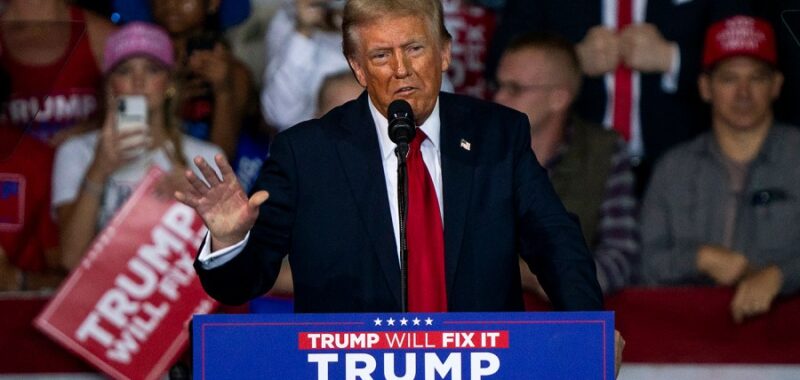
Former President Trump thinks it’s his election to lose as voters go the polls to elect a new president.
If he’s right, he’ll make history, becoming the first former president to lose office and then win it again since 1892.
“They have an expression, I hate the expression actually, but it’s ours to lose. Does that make sense to you? It’s ours to lose,” Trump told supporters in North Carolina on Monday. “If we get everybody out and vote, there’s not a thing they can do.”
The former president’s campaign team is confident because it believes its core argument, that the Biden-Harris administration broke the economy and border and Trump will fix it, will resonate with voters.
It largely shrugs off a series of off-message moments over the past couple of weeks, from a comedian’s joke comparing Puerto Rico to a garbage heap and the president’s own remarks invoking violent imagery about his critics.
While Trump may have had a couple bad news cycles, advisers and campaign aides have repeatedly noted he’s in a stronger position in the polls than he was during his previous two campaigns.
They’ve been buoyed by early voting data showing strong turnout among Republicans, and an NBC News poll published Sunday showed 66 percent of voters view the country as headed in the wrong direction, a potential drag on Vice President Harris’s campaign.
Trump faces some warning signs.
Polling shows Trump trailing Harris significantly among women, who make up a majority of the electorate and are more reliable voters. His campaign has courted young men aggressively, a move that carries some risk as they are lower propensity voter”s.
The Trump campaign has also largely relied on outside groups to handle its get out the vote efforts in swing states, an untested strategy that could either pay dividends or backfire in a razor-close election.
Even Trump, who has refused to concede he lost the 2020 election, acknowledged over the weekend a defeat was possible.
“I guess you could lose, can lose. I mean, that happens, right?” Trump told ABC News over the weekend. “But I think I have a pretty substantial lead, but, you could say, yeah, yeah, you could lose. Bad things could happen. You know, things happen, but it’s going to be interesting.”
Trump spent the final day of the campaign holding events in three battleground states. He rallied in North Carolina, the third consecutive day he campaigned in the state in a sign of its competitiveness. Trump carried North Carolina in 2016 and 2020, but polls there have shown a neck-and-neck race.
Trump held two events in Pennsylvania, which experts have pegged as the likely tipping point that will determine who will get to the 270 electoral votes needed to win the White House. He closed the day in Michigan, the same state where he capped off his 2016 and 2020 campaigns in a nod to his own superstitiousness.
The overall mood in Trump’s orbit has been a sense of cautious optimism, according to multiple officials close to the campaign. Those officials pointed to Trump having an edge over Harris on the economy and immigration, two of the top issues for voters this election season, though polling has shown Harris narrowing Trump’s advantage on the economy.
“We are cautiously optimistic about a big victory tomorrow night as long as everyone turns out to vote, and we’re seeing that people are turning out to vote,” Trump campaign spokesperson Karoline Leavitt told Fox Business Network on Monday.
The Trump campaign has issued two polling memos in recent days highlighting what it views as positive trends heading into Election Day.
The first, published late last week, cited polling averages from RealClearPolitics five days out from the 2020 election and five days out from the 2024 election to show Trump was in a better position in all seven battleground states and nationally compared to four years ago.
Another memo published Monday cited data from TargetSmart showing a decline in early voting turnout in urban areas in battleground states compared to 2020, which Trump campaign officials argued was a sign of trouble for Democrats.
“Democrats are spinning themselves and reporters by claiming that their voters will turn out on Election Day when polls show otherwise and, most importantly, that’s asking Democrat voters to do something they have absolutely no history of doing,” the memo stated. “If Democrats, who historically vote ahead of Election Day, haven’t been motivated to show up for Kamala yet, why do we expect them to show up tomorrow?”
Polling shows it is essentially a toss-up race. A Decision Desk HQ/The Hill average of polls shows Trump and Harris are separated by no more than 2 percentage points in any of the seven battleground states expected to decide the winner of the presidency.
But the headlines of the final week of the campaign have been dominated by self-created controversies from the Trump campaign, from the comedian calling Puerto Rico a “floating island of garbage” to Trump talking about would-be-assailants shooting at the press.
There are also lingering concerns about the Trump campaign’s operation on the ground in key swing states.
While the Harris campaign has for months touted its infrastructure and staff in places like Pennsylvania, Nevada, Wisconsin and Michigan, the Trump campaign opted to partner with outside groups like the Elon Musk-backed Save America PAC and Turning Point USA to lead its get out the vote efforts.
Campaign officials have argued the change has allowed Republicans to reach voters more efficiently, while focusing on those who may be less likely to cast a ballot. But even some allies are unsure if it will pay off.
“If he loses, it’s not going to be because of the issues, it’s not going to be because of the messaging, it’s just going to be because we got outworked on the ground in the blue wall,” said one Republican strategist close to the Trump campaign.

